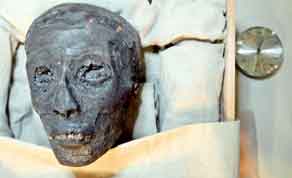
Antiquities supremo Zahi Hawass will hold a much-anticipated news conference tomorrow at the Cairo Museum, home of the fabulous treasure of Tutankhamun who died more than 3,000 years ago, to announce results of the study.
The announcement is expected to reveal "secrets of the family and the affiliation of Tutankhamun, based on the results of the scientific examination of the Tutankhamun mummy following DNA analysis," Hawass said last month.
The pharaoh known around the world as King Tut has been surrounded by mystery, ever since his solid gold and turquoise sarcophagus was found in a tomb unearthed by a British archaeologist in the Valley of the Kings in 1922.
Howard Carter's discovery was an international sensation as it brought to light a stunning treasure, including an 11kg solid gold death mask encrusted with lapis lazuli and semi-precious stones.
But mystery has lingered through the decades concerning Tutankhamun's ancestors - particularly who his mother was - and his abrupt death at about the age of 19.
Egyptian authorities have kept mum since Hawass first revealed in June 2009 that Egyptian researchers were using DNA tests to discover the lineage.
Hawass refused to allow non-Egyptian experts to carry out the testing, saying at the time that experts would carry out the work at Cairo University's faculty of medicine.
A year earlier, in August 2008, antiquities authorities said they had taken DNA samples from Tutankhamun's mummy, and from two stillborn babies found in his tomb to determine whether they were his children.
Hawass then said that the DNA tests would also determine whether the foetuses were fathered by Tutankhamun from Ankhesenpamon, the daughter of Nefertiti, who is renowned as one of history's great beauties.
It is generally believed that Tutankhamun's father was Akhenaton, the pharaoh best remember for having converted his kingdom to monotheism with the worship of one sun god, Aton.
But other Egyptologists say Akhenaton's predecessor, Pharaoh Amenhotep III, could have been Tutankhamun's father, while others say it was Smenkhkare, who is believed to have succeeded Akhenaton.
Experts are more confused when it comes to the identity of King Tut's mother. Some say it was Akhenaton's first wife Nefertiti but others believe it was Akhenaton's secondary wife, the foreign princess Kiya.
Maya, Tutankhamun's childhood nurse, is another name which has surfaced.
The boy king's death more than three millennia ago remains the subject of dispute among historians, with some believing he died when a leg injury turned gangrenous, others saying he was murdered by a blow to the head.
The mysteries surrounding his ancestors and his abrupt death as he emerged from adolescence underscore "the romantic side of this story," says French Egyptologist Marc Gabolde, an expert on Tutankhamun.
In 2007, the reconstructed face of Tutankhamun was revealed to the public for the first time since his death. He is believed to have reigned from around 1333 BC to 1324 BC.
Archaeologists are divided among those hoping the DNA results will lead to a scientific breakthrough and others who believe DNA testing can not be conclusive.
"We need other archaeological proof to establish with certainty the lineage of Tutankhamun," said Cairo University professor Abdel Halim Nurreddin. "DNA testing is not enough."
Michel Wuttmann of a Cairo-based French archaeology institute said Wednesday's revelations could help unravel other "less spectacular" mysteries.
American archaeologist Raymond Johnson meanwhile told AFP: "We are very interested in having another tool in the study of these ancient families."
"I think other analyses have proven that it can be very useful in showing close genetic relationship," he added.
Source: Agence France-Presse



Reader Comments
to our Newsletter